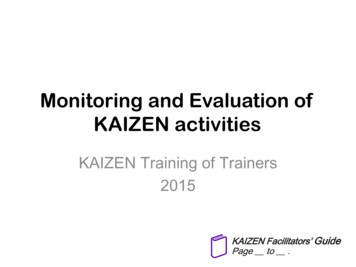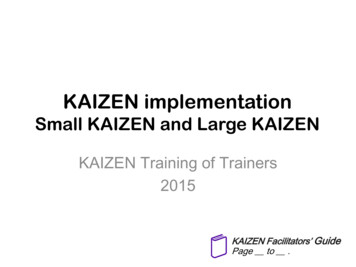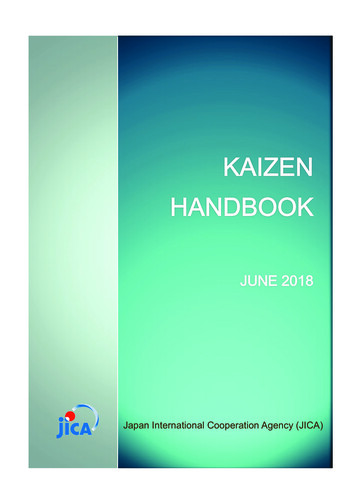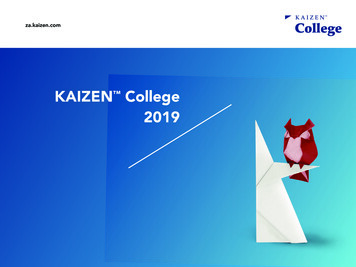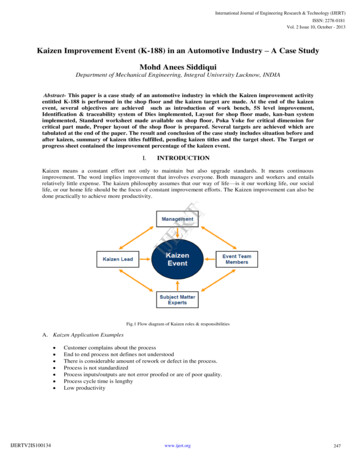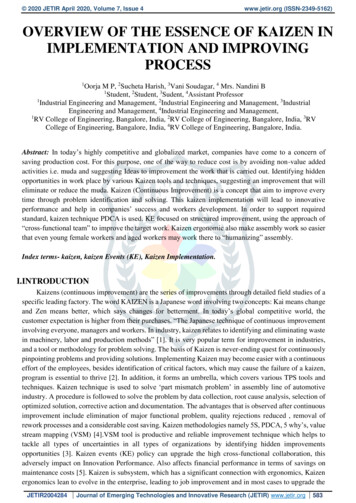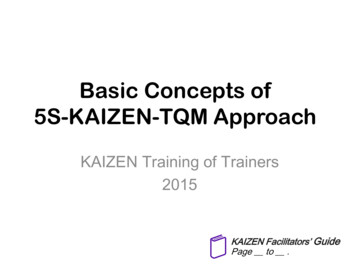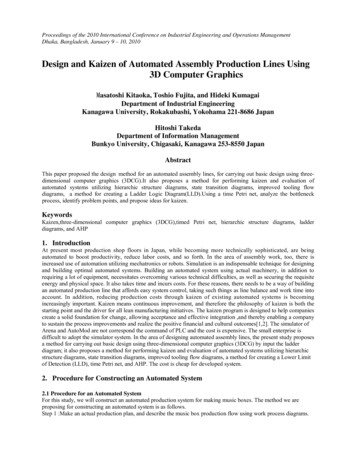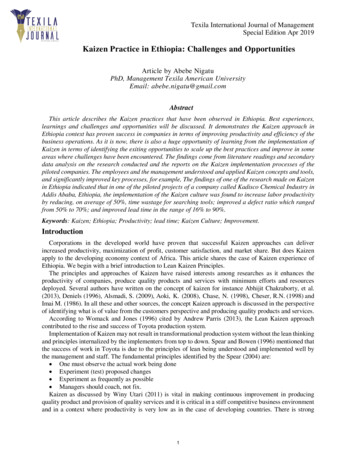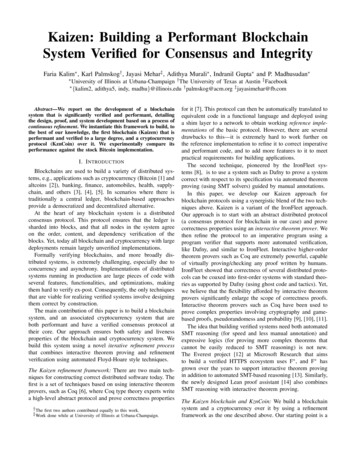
Transcription
Kaizen: Building a Performant BlockchainSystem Verified for Consensus and IntegrityFaria Kalim , Karl Palmskog† , Jayasi Mehar‡ , Adithya Murali , Indranil Gupta and P. Madhusudan University {kalim2,of Illinois at Urbana-Champaign † The University of Texas at Austin ‡ Facebookadithya5, indy, madhu}@illinois.edu † palmskog@acm.org ‡ jayasimehar@fb.comAbstract—We report on the development of a blockchainsystem that is significantly verified and performant, detailingthe design, proof, and system development based on a process ofcontinuous refinement. We instantiate this framework to build, tothe best of our knowledge, the first blockchain (Kaizen) that isperformant and verified to a large degree, and a cryptocurrencyprotocol (KznCoin) over it. We experimentally compare itsperformance against the stock Bitcoin implementation.I. I NTRODUCTIONBlockchains are used to build a variety of distributed systems, e.g., applications such as cryptocurrency (Bitcoin [1] andaltcoins [2]), banking, finance, automobiles, health, supplychain, and others [3], [4], [5]. In scenarios where there istraditionally a central ledger, blockchain-based approachesprovide a democratized and decentralized alternative.At the heart of any blockchain system is a distributedconsensus protocol. This protocol ensures that the ledger issharded into blocks, and that all nodes in the system agreeon the order, content, and dependency verification of theblocks. Yet, today all blockchain and cryptocurrency with largedeployments remain largely unverified implementations.Formally verifying blockchains, and more broadly distributed systems, is extremely challenging, especially due toconcurrency and asynchrony. Implementations of distributedsystems running in production are large pieces of code withseveral features, functionalities, and optimizations, makingthem hard to verify ex-post. Consequently, the only techniquesthat are viable for realizing verified systems involve designingthem correct by construction.The main contribution of this paper is to build a blockchainsystem, and an associated cryptocurrency system that areboth performant and have a verified consensus protocol attheir core. Our approach ensures both safety and livenessproperties of the blockchain and cryptocurrency system. Webuild this system using a novel iterative refinement processthat combines interactive theorem proving and refinementverification using automated Floyd-Hoare style techniques.The Kaizen refinement framework: There are two main techniques for constructing correct distributed software today. Thefirst is a set of techniques based on using interactive theoremprovers, such as Coq [6], where Coq type theory experts writea high-level abstract protocol and prove correctness properties† The first two authors contributed equally to this work.‡ Work done while at University of Illinois at Urbana-Champaign.for it [7]. This protocol can then be automatically translated toequivalent code in a functional language and deployed usinga shim layer to a network to obtain working reference implementations of the basic protocol. However, there are severaldrawbacks to this—it is extremely hard to work further onthe reference implementation to refine it to correct imperativeand performant code, and to add more features to it to meetpractical requirements for building applications.The second technique, pioneered by the IronFleet systems [8], is to use a system such as Dafny to prove a systemcorrect with respect to its specification via automated theoremproving (using SMT solvers) guided by manual annotations.In this paper, we develop our Kaizen approach forblockchain protocols using a synergistic blend of the two techniques above. Kaizen is a variant of the IronFleet approach.Our approach is to start with an abstract distributed protocol(a consensus protocol for blockchain in our case) and provecorrectness properties using an interactive theorem prover. Wethen refine the protocol to an imperative program using aprogram verifier that supports more automated verification,like Dafny, and similar to IronFleet. Interactive higher-ordertheorem provers such as Coq are extremely powerful, capableof virtually proving/checking any proof written by humans.IronFleet showed that correctness of several distributed protocols can be coaxed into first-order systems with standard theories as supported by Dafny (using ghost code and tactics). Yet,we believe that the flexibility afforded by interactive theoremprovers significantly enlarge the scope of correctness proofs.Interactive theorem provers such as Coq have been used toprove complex properties involving cryptography and gamebased proofs, pseudorandomess and probability [9], [10], [11].The idea that building verified systems need both automatedSMT reasoning (for speed and less manual annotation) andexpressive logics (for proving more complex theorems thatcannot be easily reduced to SMT reasoning) is not new.The Everest project [12] at Microsoft Research that aimsto build a verified HTTPS ecosystem uses F , and F hasgrown over the years to support interactive theorem provingin addition to automated SMT-based reasoning [13]. Similarly,the newly designed Lean proof assistant [14] also combinesSMT reasoning with interactive theorem proving.The Kaizen blockchain and KznCoin: We build a blockchainsystem and a cryptocurrency over it by using a refinementframework as the one described above. Our starting point is a
recently developed formalization of the blockchain/blockforestprotocol in Coq by Pirlea and Sergey [15], where the abstractdistributed protocol works in an asynchronous out-of-ordermessage-passing environment and where several properties areproved regarding validity of the reachable global states of thesystem as well as an eventual consistency property. The goalwe set for ourselves is to take this protocol expressed in Coqand to continuously refine it to a usable performant imperativeimplementation of an altcoin, with proven refinement guarantees. The proven refinement ensures that our core protocolimplementation inherits all the safety and liveness (eventualconsistency) properties proved for the abstract protocol in Coq.We develop our KznCoin cryptocurrency on top of theKaizen blockchain and evaluate its performance againstthe stock Bitcoin implementation [16]. We argue that theblockchain can be used as a backbone for a full-fledgedBitcoin-like cryptocurrency that uses standard proof-of workmeasures for controlling the growth of the chain.In our experience in this project, we found our refinementmethodology to be friendly to systems developers, as it allowsteams with different expertise to collaboratively build a complex verified system. Experts in interactive theorem proverscan work on designing abstract distributed protocols andprove complex properties. Meanwhile, systems engineers whoare not necessarily trained in formal verification or abstractspecification languages, can work on refining the protocolusing imperative code using automated verification techniques,and concentrate their efforts on instantiating the protocol forparticular applications and making them more performant,keeping control of the design at all times.We focus our verification on the core blockchain consensusproperties under crash failures and eventual message delivery.Proving correctness under Byzantine models remains an openproblem in the community (see Section IX on related workand the discussion in Section VIII).Our work can also be seen as exploring a new point indistributed systems verification, namely computation-intensivedistributed systems. Systems like IronFleet focused on distributed systems that were not data-intensive (key-valuestore, state machine library), and involved relatively lowcomputation. A blockchain system involves relatively intense local computation which nodes execute (work done onthe blockchain, such as computing hashes, validating longstretches of a growing blockchain, etc.). Consequently, alot of of effort is devoted to refining code with imperativedatastructures that speed up this computation. We also performa final refinement that is carefully argued, but not formallyverified, to increase the system’s performance.The contributions of this paper are: The engineering of a performant blockchain (Kaizen) anda cryptocurrency over it (KznCoin) in C#, built usinga continuous refinement that combines interactive theorem proving and automated refinement. Our core systemfirst achieves a provable refinement of a core verifiedblockchain consensus protocol formulated by Pirlea andSergey [15], preserving all their safety and liveness properties. We then add at the deployment layer a network shimand carefully argued (but not formally verified) refinementsto gain further performance. An evaluation of the cryptocurrency against a referenceBitcoin implementation on a real network that shows thatthe system can be used as a backbone for a full-fledgedBitcoin-like cryptocurrency that uses standard proof-ofwork measures for controlling the growth of the chain.We provide artifacts and supplementary material at this URL:https://madhu.cs.illinois.edu/kaizenII. BACKGROUNDA. Blockchains and BitcoinA blockchain is an open, distributed ledger that can recordtransactions between two parties in serializable order, in averifiable and permanent way [17], [18]. Bitcoin is a decentralized cryptocurrency that uses Nakamoto consensus [1]to maintain a blockchain of transactions across an untrustedpeer-to-peer network [18]. The peers in the network generallybelong to different organizations or companies so that there isno single point of authority. These peers use gossip protocolsto propagate transactions and blocks further in the network.A node in the network can transfer currency from their address to another by creating a digitally signed transaction. Anynew transaction must pass a reference to a previous transactionthat the node might have received from another address. Thisensures that all nodes in the network can cryptographicallyverify the creator of the transaction.Tamper-proof chain: Each block has a unique hash andcontains the hash of the preceding block, as well as the Merklehash of its transactions. The first block in the chain, calledthe genesis block, is defined in the protocol. To effectivelytamper with a transaction in the middle of the chain, anadversary would have to tamper with the transaction’s hash inthe block. This would cause the hash of the block to change.The adversary would then have to change the hash of the blockin the next block in the chain until the head. Other nodes withthe same chain would be able to detect this tampering.Proof-of-Work: Nakamoto consensus proposes using proofof-work to periodically choose the next node that gets to adda new block to the chain. Calculating proof-of-work refers tofinding the solution to a cryptographic hash function H, wherethe solution is defined by string y, such that given string x asinput, H(y.x) — the hash of the concatenation of the two — issmaller than a target value. The miner that finds the proof firstsends the newly minted block to other peers in the network.Other miners add the block to the chain if they are able toverify that the proof is correct.Forking and Consensus: The blockchain forks when twovalid blocks point to the same previous block. The protocolresolves forks using a set of rules that choose the branchthat has more weight in terms of mining power. Consensusin Bitcoin is achieved when all nodes have the same blocksin their local best blockchain. Miners continue to add blocks
to the best branch they know of, until one branch becomessignificantly longer and is considered to be the main chain.Due to forking, transactions are usually not considered fullycommitted into a chain, unless there are a sufficient numberof blocks (usually six in Bitcoin) after their containing block.B. Verification paradigmsWe assume familiarity with two verification paradigms—Coq-based interactive theorem proving and Dafny-based SMTaided mostly automated verification.C. System ModelDistributed System Model: We assume a distributed systemwhere nodes are connected via a network where any node cansend messages to any other node. While the nodes or networkare not Byzantine, nodes may fail by crashing. Messages maybe sent asynchronously and concurrently, and may be dropped,delivered out of order, or duplicated. Our KznCoin system isrun on a real cluster and injected with real Bitcoin traces.Trusted Computing Base (TCB): Our verification workmakes reasonable assumptions about underlying systems: (a)Coq proof checkers, (b) Dafny and its provers, (c) compilers,(d) translation from Coq protocol to Dafny contracts (Phase 3),(e) reasonable assumptions (e.g., hash functions being injective), (f) a network shim layer that can send and receivemessages (Section VI-B).III. T HE K AIZEN F RAMEWORKWe describe our Kaizen framework at a high level1 . Thekey idea is to combine interactive theorem proving in proofassistant (based on higher-order logic), with verified refinement using Floyd-Hoare style mostly-automated reasoning.A. Refinement methodology based on movers:Our refinement is divided in three stages. Our methodologyis stylized to allow sequential refinement throughout. Focusingon sequential code reduces complexity of refinement in spiteof asynchronous message passing in the distributed system.The protocol is specified using code snippets of the form:R; C; SUwhere R is a sequence of receive-messages, C is a terminatinglocal computation at the node, and SU is a set of sendmessages and updates of the current state of the node. Weassume that these rules are executing atomically, withoutinterruption.The rule-based approach has two advantages. First, wecan distribute the protocol across any set of nodes, and notworry about interleavings where the code is (in global time)interrupted by computation at other nodes. The reason is thatany such computation can be reordered into a computationwhere all blocks are executed atomically. The argument follows from the mover arguments for reduction by Lipton [19],as receive-messages are right-movers and send-messages areleft-movers, while local computations are both left- and rightmovers. Consequently in any global computation where this1 Kaizenmeans continuous improvement.rule executes, interleaved by actions at other nodes, we canalways reorder the execution to an equivalent execution wherethe rule is executed atomically.Second, this approach significantly reduces proof burdenfor safety properties, and allows us to work with a sequentialverification tool like Dafny. We can refine each step of theprotocol as sequential code, and not worry about interleavings.Such refinement is not new— the receive-compute-send/updateis similar to the actor model of computation [20] and similarrefinement styles have been explored before, for instance inthe IronFleet system [8].Third, when we prove that the local computation terminates(which we do in our proofs in Dafny), even liveness propertiesare preserved by the refinement. For every infinite computationin the refined system, since it cannot be stuck in a localcomputation in a rule, and since rules simulate the abstractprotocol, we can find an equivalent infinite execution of theabstract protocol. This immediately argues that any livenessproperty in the abstract system is preserved in the refinedsystem (we need to be careful that we do not introduce newmessaging or change the system model for messages). Wehence inherit all the safety and liveness properties of theoriginal blockchain protocol of Pirlea and Sergey [15]. TheIronFleet system [8] uses a similar methodology for provingliveness; however, in their system, liveness properties areproved on the abstract protocol using Dafny by embeddingTLA, while in ours they are proved in Coq.B. Kaizen refinement stagesThe first of our three refinement stages consists of leveraging a proof assistant (Coq in our case) to develop an abstract,formal protocol describing the behavior of the distributedsystem and proving its correctness. The second stage consistsof refining the formal description to imperative code in averification-aware language and environment (Dafny in ourcase). The third stage consists of refinements using a practicalprogramming language (C# in our case) for realizing animplementation of the distributed system. Figure 1 depicts thethree stages and the phases within them.IV. S TAGE I: R EFINEMENTS IN C OQA. Phase 1: Protocol specification and verificationHere, we specify and prove the protocol in Coq. We encodethe state of each network node using Coq’s algebraic datatypesand use pure state update functions for network messageprocessing (like work in [21]). Correctness proofs can then beperformed over a transition system capturing network behaviorwhere these functions are called per step.State and transitions can involve parameter datatypes andfunctions over which the protocol is parameterized, along withaxioms expressing the necessary properties those datatypes andfunctions must fulfill for the specification to hold. In principle,properties of data and functions unrelated to the axioms do notmatter in this phase.For Kaizen, we build on work by Pirlea and Sergey [15]to define a general blockchain consensus protocol where the
STAGE IAbstractprotocoldesign &verification inCoqPHASE 1STAGE IISTAGE IIIRefinement inCoqTranslation ofabstractprotocol toDafnycontractsRefinement toimperativecode in DafnyRefinement inDafny ions in C#PHASE 2PHASE 3PHASE 4PHASE 5PHASE 6Coq expertsDafny expertsDafny experts andsystems engineersTranslation toexecutablecode on adistributednetworkPHASE 7Systems engineersFig. 1: The Kaizen Framework.key operations (e.g., transaction validation, procedures forgeneration of proofs of work or stake) are parameters. Themain property proved in this work is eventual consistency:that in a quiescent state, all nodes have a canonical ledger.This is proved by proving a safety property that states that ina clique topology, there exists a global block forest which isa superset of the local forest of any node, which is a validblock forest that contains the canonical ledger (which is aledger that is greater than or equal to any local ledger). Thisglobal block forest is in fact the one obtained by adding to thelocal block forest at any node all the blocks in-flight at the timeto it. In a quiescent state, there are no in-flight messages andhence the local blockchains are in consensus. The protocolabstracts away several functions requiring only basic sanityproperties on them; this includes transaction validation, blockchain validation, and the fork-chain rule.The goal of our work is to build a blockchain systemthat provably inherits this eventual consistency property andthe various safety properties of the above protocol. Thisconstitutes the precise set of verified properties that we target.The Coq encoding defines blocks as a datatype with aprevious-block “pointer” hash, a list of transactions, and aproof-of-work/stake, as follows:Record Block : mkB { prevBlockHash : Hash;txs : seq Transaction; proof : VProof }.The state of a node in Kaizen is defined by its globallyunique name, a list with the name of its peers, a list (pool)of transactions, and a forest of blocks, in the form of a finitemap from hashes to blocks:Record State : mkS { id: Address; peers: seq Address;forest: map Hash Block; txpool: seq Transaction }.At any time, a node can obtain its longest known chain ofblocks rooted in the special genesis block, where longest isdefined according to a parameterized relation (“fork choicerule”), which is not concretely defined. All transactions inblocks in this chain are validated using the parameter functiontxValid. One axiom, used in our correctness proofs, statesthat txValid returns true when passed any transaction andthe empty chain: t, txValid t [::]. We check blockvalidity via the function:Definition valid chain block (bc:seq Block)(b:Block): VAF (proof b) bc (txs b) &&all [pred t txValid t bc] (txs b)].B. Phase 2: Initial protocol refinementFor KznCoin, we refine the abstract blockchain datatypesand functions according to the specification of Bitcoin [1],[16]. For example, representing byte vectors as lists of mathematical integers, the type of transactions, Transaction, isdefined in Coq as follows:Record TIn : mkTI { prevout hash : seq Z;prevout n : seq Z; scriptsig : seq Z;sequence : seq Z }.Record TOut : mkTO { value : seq Z;scriptpubkey : seq Z }.Record Transaction : mkT { version : seq Z;ins : seq TIn; outs : seq TOut; locktime : seq Z}.Here, the definitions reflect that KznCoin transactions consistof a number of inputs (pointing to previous transactions)transferring cryptocurrency to a number of output addresses.We also define block and transaction hashing functions,which are parameters in the abstract protocol, to use SHA256 hashing as prescribed by Bitcoin, i.e., twice on properlyconcatenated vectors of bytes. We used Coq’s module systemto verify that the functions and data in our protocol refinementhave the proper signatures, so that the correctness theorem canbe reestablished [22].Addressing Obstacles Faced: We encountered several obstacles from [15] that prevented us from capturing the Bitcoinspecification. To overcome these obstacles, we made severalimportant proof-preserving changes to the abstract protocoland related definitions in Coq; these changes were all approvedby Pirlea and Sergey.One obstacle was that the abstract protocol did not permitadding new transactions when blocks are minted. This rulesout coinbase transactions that are added by miners to obtaina block reward. We resolved this by adjusting the functionparameter genProof, used during block minting.Another obstacle was that the validator acceptance function,VAF, which checks the validity of a proof-of-work or proofof-stake, was not called except during block minting in theabstract protocol, while Bitcoin specifies that it has to be called
on all blocks in a chain. We resolved this by adding the VAFcall to the function valid chain block above, which isused when obtaining the longest chain from a block forest.V. S TAGE II: R EFINEMENTS IN DAFNYIn Stage II, we manually translate the data structures andfunctions in Stage I from Coq to Dafny, and refine theresulting definitions to performant imperative code in Dafny.Our implementation of KznCoin consists of several classesand methods whose contracts express that they conform tothe behavior of some function translated from Coq. Thiscontrasts with IronFleet’s approach [8], wherein the equivalenttranslation is entirely within Dafny.A. Phase 3: Protocol translation to DafnyWe manually translated all relevant datatypes, functions,and refinements from Phase 1 and Phase 2 to equivalentDafny definitions. Due to the close similarities betweenCoq’s programming language and Dafny’s purely functionalfragment, the translation was straightforward. For example,the Block and State datatypes (presented in Coq above)are defined in Dafny as:datatype Block Block(prevBlockHash:Hash,txs:seq Transaction , proof:VProof)datatype State Node(id:Address,peers:seq Address , forest:map Hash,Block ,txpool:seq Transaction )Preparing to Transition from Functional to ImperativeCode: As an initial step, we set up a Dafny class that holds thenode state and implements methods for protocol state updates:class StateImpl {var id :Address;var peers :. . .; var forest :. . .; var txpool :. . .;ghost var st:State;predicate Valid() { . . .}method ProcMsgImpl(from:Address, msg:Message,ts:Timestamp) returns (pt:seq Packet )requires Valid(); ensures Valid();ensures st procMsg(old(st), from, msg, ts).0;ensures pt procMsg(old(st), from, msg, ts).1;{ . . .}method ProcIntImpl(tr:InternalTransition,ts:Timestamp) returns (pt:seq Packet )requires Valid(); ensures Valid();ensures st procInt(old(st), tr, ts).0;ensures pt procInt(old(st), tr, ts).1;{ . . .}}The variables peers, forest, and txpool can be of any(mutable) type as long as they have a representation in termsof the (immutable) algebraic datatypes in the State datatype. For example, peers could be an array, which has asequence representation. The Valid() predicate then assertsthat the representations of the variables are consistent withwhat is stored in the ghost variable st, in the style advocatedby Leino [23]. In turn, this means that the contracts forProcMsgImpl and ProcIntImpl express that these methods perform state updates consistent with the Coq functionsprocMsg and procInt (so the Coq correctness proofs holdfor systems implemented using StateImpl objects).In essence, with the Dafny modules and the StateImplclass, we have obtained constraints under which all furtherrefinement must be performed, as well as the interface forunverified code to call our verified code.B. Phase 4: Refinement to imperative code in DafnyNext, we refine the functional code into imperative code. Westart by implementing Dafny methods for each function calledin procMsg and procInt. Because the code of a methodcorresponds closely to its specification, and we use the samealgebraic datatypes, it is straightforward to do this translationfrom functional code into Dafny, and to prove the specificationcorrect. We also encode stubs for methods that are deferredto C# code inside Dafny, and write the corresponding methodsignatures in C# code that gets linked to the code compiledfrom Dafny. This process yields an executable and verified(though incomplete) implementation of StateImpl.Next, we iteratively replace functional code in the verifiedDafny implementation. We (a) replace algebraic datatypeswith mutable datastructures such as arrays and classes, and(b) replace functional idioms such as recursion and patternmatching by imperative idioms such as loops and accesses tomutable fields. For example, we refined the Dafny sequencesof transactions in the node state (txpool) into linked lists thatalso store the list size, and with ghost variables capturing theheaplet of the list which is needed for mutable datastructurereasoning. We then systematically replace all methods actingon sequences of transactions to instead act on linked lists,while preserving their specification (now in terms of thesequence representing the linked list).C. Phase 5: Performance optimizations & Dafny refinementsRefinements here optimize performance in three ways:Data structure refinements: A prime example of theserefinements in our work involves our encoding of a blockforest as a finite map from Hashes to Blocks, similar to theformalization in the work by Pirlea and Sergey [15]. Our initialimplementation used Dafny’s map type, which we found tobe inefficient due to the number of accesses (e.g., by themethod that returns the FCR-longest valid chain in the blockforest). Instead we store hashes using a binary search treeand implement a map over it. We define this in Dafny, andprove that the operations on it—including addition, removal,lookup, and copy—satisfy the same contracts as that of themap structure. This took about 680 lines of Dafny code.Refinements to operations on data structures: An exampleof such an optimization is our method to append two linkedlists (defined in Phase 4 Section V-B). Its implementationadded one element at a time as this made verification easy.But this is inefficient as it involved multiple passes and pointermanipulations. We replaced this with a more efficient onepass algorithm. This involved a notion of validity of linkedlist segments and the maintenance of complex invariants.Recursive to iterative implementations: We identified about20 auxiliary functions that were implemented recursively andrefined them to more efficient iterative versions. For example,
the method to validate a list of transactions with respect toa blockchain would validate the first transaction and thenrecursively compute on the rest of the list. This had to bereimplemented using iteration (using array semantics of thelist containing the transactions).The first two classes above are hard. Defining data structuresthat are allocated on the heap often have definitions (of thevalidity of their representations) that are recursive and involvecomplex relationships between their attributes.VI. S TAGE III: R EFINEMENTS IN C#We build KznCoin from our verified system Kaizen byadding Bitcoin-specific functionality (Section VI-A) and connect it to other peers via a network shim layer (Section VI-B).A. Phase 6: Application specific functionsWe fill in methods that were left unspecified in the abstract Coq/Dafny protocol. Any methods that needed verification were already handled through the separation describedPhase 4. Consequently, we only need to add methods in C#that do not need verification. Transaction Validity (txValid): In KznCoin, a node mustvalidate each transaction to ensure that no transaction withthe same hash exists in the chain already, the transaction’sparent transactions exist, and the transaction’s parent transactions are unspent to prevent double-spending attacks. Validator Acceptor Function (VAF): We found that thespecification in [15] did not completely satisfy Bitcoin semantics and thus we modified it while developing KznCoin(e.g., it did not support coinbase transactions; see Phase 1).Apart from a duplicate block check, we also check that thecalculated value of its cryptographic hash proof is correct. Generate Proof: KznCoin uses proof-of-work to mintblocks. Every miner solves a hash problem with difficultybased on the nonce value. We set this nonce difficulty levelto a negligible value during our evaluation to measure theoverhead of only the blockchain mechanisms. Fork Chain Rule (FCR): This function is used to comparethe weights of two chains and establish a total orderbetween them. The specification [15] is indifferent tohow such an order is
https://madhu.cs.illinois.edu/kaizen II. BACKGROUND A. Blockchains and Bitcoin A blockchain is an open, distributed ledger that can record transactions between two parties in serializable order, in a verifiable and permanent way [17], [18]. Bitcoin is a de-centralized cryptocurrency that uses Nakamoto consensus [1]
